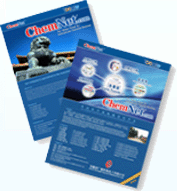Chemical News
-
Farmers slowly cultivate a new image
https://www.chemnet.com May 31,2010 China Daily
BEIJING - Vehicles of all shapes and sizes jockey for position under the early morning sun, their drivers honking their presence in a cacophony of apparent chaos. Plump red tomatoes, lurid green cabbages and slender sticks of celery are just some of the produce being loaded and unloaded from the jam of carts, trailers and the backs of lorries.
This is Xinfadi in southwest Beijing, believed to be the world's biggest wholesale market for fruit, vegetables, meat, seafood and seeds. Measuring more than 100 hectares, it provides a trading center for as many as 80,000 people every day, 24 hours a day, 365 days a year. Dealers and buyers come from Tianjin, Hebei, Henan, Shandong, Inner Mongolia and even as far as Fujian, Yunnan and Hainan.
In early July it is due to expand further with the opening of the Xinfadi International Trade Center when traders from the United States, Germany, Japan, South Korea, Thailand, the Philippines, Singapore, New Zealand and Chile will strike deals with their Chinese counterparts in a specially-constructed market hall. They will be taking advantage of China's booming agriculture business.
"The rise in some sectors has been so fast that it almost defies description," said Scott Rozelle, Cheung Kong Scholar and guest professor at Beijing's Renmin University of China. "Every two years China adds the equivalent of the vegetable production capacity of California. The cultivated area dedicated to fruit orchards is more than 5 percent, more than double the share of the next closest major agricultural nation, including the US, the European Union, Japan and India. There has also been a continuous and rapid rise in livestock and fisheries."
In March Premier Wen Jiabao announced plans to allocate 818.3 billion yuan for agriculture, farmers and rural areas, an increase of more than 93 billion yuan over last year, and said local governments would also increase their investment. He said the government would spend 133.5 billion yuan to subsidize agricultural production, a year-on-year increase of 6.04 billion yuan.
The boost reflected the need to prepare for the possible damaging fallout from climate change, which many believe was responsible for this year's drought in Yunnan that has had a damaging effect on agricultural output. It would also benefit domestic consumption during a period of economic uncertainty, the needs of an ever-rising population and it would counter the widening wealth gap between the rising number of urban dwellers and those who remain in the countryside.
The latter group makes up more than half of the total 1.3 billion population and, in the interests of social harmony, the government does not want to disenfranchise them, say analysts. According to the National Bureau of Statistics, the average annual income of farmers stood at 5,153 yuan in 2009, up 8.5 percent from a year earlier, but still less than a third of average urban incomes.
Agriculture is an important economic sector in China, employing more than 300 million people. Its share of gross domestic product has fallen from 40 percent in 1970 to less than 10 percent today, but that is due to the spectacular growth of other industries.
China ranks first in worldwide farm output, primarily producing rice, wheat, potatoes, sorghum, peanuts, tea, millet, barley, cotton, oilseed, pork and fish. The country, according to Rozelle, is 98 to 99 percent self-sufficient in food production with agricultural exports worth $17.3 billion in 2004.
However, it belies the economic diktat that big is best. Farm sizes have remained much the same size as in the late 1970s, when farmland began to be returned to individual households.
Subsequent policies have made life easier for Chinese farmers with the granting of certain tightly controlled rights to farmers to lease their land to other people for longer, a move regarded as key to the ultimate creation of the highly industrialized and highly profitable megafarms seen in the US and Australia.
Nonetheless, many rural landowners, even those who have taken jobs as migrant workers in cities, remain reluctant to give up their land, regarding it as a form of social security. They mainly leave behind the old and middle-aged women, according to Rozelle.
"Ninety-five percent of young men are in the cities working in industry and in the service sector. Most have never farmed and never will. The average farm size is one acre. How do you go to 20 acres? It means 19 people will have to sell their land."
Although the use of mechanism has risen with tractor makers such as John Deere establishing a presence in China and increasing its sales revenue in the country by 300 percent over the past five years, the nation's farmers still lag behind the productivity of developed nations.
"In Australia and the US the average corn farmer spends one to two days on every hectare," said Rozelle. "In 1990, a Chinese farmer spent 200 days per hectare. Today he spends less than 100 days."
Rozelle predicts that the face of China's agricultural industry will change over the next decade but first wages must rise, farm sizes must increase and branding and marketing must mature. "It will happen in the next 10 years if China is successful in continuing its transition to a modern economy," he said.
According to Mao Changqing, the chief agricultural analyst at CITIC Securities, there is a lot of private investment interest in seeing a revolution in China's rural land system but he says the government has no plans to encourage bigger farms in the near future. One factor behind this is China's stated desire to maintain a minimum of 120 million hectares of arable land to ensure agricultural self-sufficiency.
There are also fears about what farmers could do once they have sold their land. Because of the hukou system they do not possess the same political and social rights and benefits as urban residents.
However, there are indications that industrialization is creeping ahead. Last year Kohlberg Kravis Roberts & Co LP announced the final completion of a series of investments worth $150 million in Ma Anshan Modern Farming Co Ltd, a leading dairy farming company headquartered in China's central province of Anhui known as Modern Dairy.
It is one of the largest operators of centralized large-scale dairy farms in China. With KKR's investment, Modern Dairy said it was intending to construct another 20 to 30 large-scale farms in China as well as to pursue acquisitions over the next few years, in order to capitalize on the industry's growth.
The milk supplier has about 40,000 dairy cows and produces more than 150,000 tons of raw milk a year, KKR said. "We have brought in not only capital but, more importantly, international best practices and expertise in the dairy farming industry that will help Modern Dairy develop world-class facilities," David Liu, KKR's head in China, said in a statement.
Industrialization
With growing industrialization comes the need for greater government supervision. China, the world's third-largest milk producer, is pushing dairy farms to meet higher standards after melamine, an industrial chemical used to make plastics and tan leather, was found in some infant milk powder and other dairy products last year.
Some suppliers had added the chemical to diluted milk to make the protein content appear higher than it was, the Chinese government said.
Nonetheless, this has not deterred other foreign investors. Fonterra said in February it wanted to invest in two more dairy farm operations in China near its existing pilot farm. Last year China's big dairy market posted double-digit annual growth and a demand of 27 billion liters of milk.
Fonterra had identified several possible sites for the new farms near Tangshan, and would consider partnering on the investment. Each of the new farms was planned to be of a similar size to Tangshan, with around 35 hectares of land and around 3,300 milking cows, creating employment and training opportunities for 350 people.
The company said due diligence was under way and the aim was to complete the final long-term lease agreement by mid-2010.
Furthermore, investment bank Goldman Sachs bought 10 intensive poultry farms in Hunan and Fujian provinces in 2008 for $300 million in the race to capture assets in the food production market. Goldman already holds a 13 per cent stake in China Yurun Food Group, the country's second meat and poultry processor. Its net income has more than tripled in the past three years.
Xinfadi's future
What does all this mean for Xinfadi? Is China ultimately heading for a Western-style system in which giant supermarkets deal directly with farmers in order to improve their control, consistency in produce and cost-effectiveness? Not any time soon, according to Xing Mengyu, vice-manager of Xinfadi.
He points out large supermarkets such as Walmart, Auchan and Hualian buy many of their products at the market. Xinfadi tomato dealer Dong Jianrong from Zhangjiakou in Hebei province estimated one-third of the produce went to supermarkets, with two-thirds going to small retailers.
According to a 2008 study by Elsevier into the production and procuring of horticultural crops in northern China, not one farmer sold to a supermarket or specialized supplier but used small trading groups. The same survey suggested supermarkets got two-thirds of their vegetables from local wholesale markets and one-third from other sources.
The paper, to which Scott Rozelle contributed, concluded: "Although we showed the rise in horticultural crops was paralleled by a surge in the emergence of supermarkets in urban areas, there has been almost no penetration of modern wholesalers or retailers into rural communities. Since China's horticultural economy is almost completely unregulated and since China's road and communication networks have improved remarkably over the past 10 years, small traders working with a limited amount of capital and using extremely large amounts of low-cost labor (while utilizing the relatively efficient road and communication infrastructure) appear to be out-competing all other types of would-be procurement agents."
The survey found competition between traders was so fierce and profit margins so thin there was little to attract new, more innovative entrants. It showed consumers wanted their food produce cheap and the existing system was the cheapest, adding: "It may be that, at least now and in the immediate future, China will still be relying mostly on traditional wholesale channels. If this is true, food safety in China's food system may suffer.
While this may be bad news for the quality-conscious consumer, it is good news for small, poor farmers. It should be recalled, however, how fast China is changing in so many areas.
"If any one (or perhaps several) of these characteristics changed, we might expect to see China's horticultural economy - from both the supply and procurement side - change. The change, like so many other things in China, could be very rapid."
If the Carrefour chain of supermarkets is anything to go by, that change may have already begun. It introduced its Carrefour Quality Line (CQL) to China last year, said Chen Bo, corporate communications manager of Carrefour China. The company says it now controls every step from farm to store including growing, processing, packaging and delivering in an effort to ensure taste, safety and traceability to consumers while also guaranteeing added-value, including higher income for farmers and environmentally friendly practices. The company also set up direct partnerships with farmers.
Producers and growers must follow strictly Carrefour's specifications to ensure that those commitments are respected. It says it cut out all the middlemen in the supply chain, which allows the stores to pay more farmers and keep prices competitive.
However, Xinfadi's Xing Mengyu said Carrefour was still buying produce at the wholesale market.
 Print |
Print |  add to Favorites |
add to Favorites |  Close
Close


